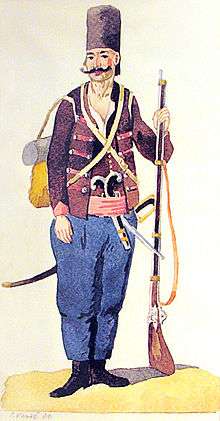Serbian Free Corps
| Serbian Free Corps | |
|---|---|
 Illustration of a volunteer | |
| Active | 1787 — 1792 |
| Country |
|
| Allegiance | Habsburg Monarchy |
| Role | Serbian liberation and unification with the Habsburg Monarchy |
| Size | 5–8,000 |
| Garrison/HQ | In Banat Military Frontier |
| Nickname(s) | frajkori |
| Engagements |
|
| Disbanded | 1792 (Treaty of Sistova) |
| Commanders | |
| Main commander | Mihailo Mihaljević, major |
| Notable commanders | Koča Anđelković Stanko Arambašić and Radič Petrović |
The Serbian Free Corps (German: Serbische Freikorps), known simply as frajkori (Serbian Cyrillic: фрајкори), was a volunteer militia composed of ethnic Serbs, established by the Habsburg Monarchy, to fight the Ottoman Empire during the Austro-Turkish War (1787–91). The conflict with Turkish forces ultimately proved inconclusive. The rebellion in the Sanjak of Smederevo and militia's operations resulted in the period of Habsburg-occupied Serbia, which took place from 1788 to 1792. Ultimately, the Serbian volunteer corps had the legacy of promoting the creation of future paramilitaries, such as during the First Serbian Uprising.
History
A Serbian freikorps of 5,000 soldiers had been established in Banat (Banat Military Frontier), composed of refugees that had fled earlier conflicts in the Ottoman Empire.[1] The Corps would fight for liberation of Serbia and unification under Habsburg rule.[1] The main commander was the Austrian major Mihailo Mihaljević.[2] There were several freikorps along the Habsburg-Ottoman frontier.[3] Mihaljević's Free Corps, the most notable, was active from Šumadija to Podrinje, and across the Morava there was the Braničevo Free Corps; in Croatia the St. George Free Corps; in Bosnia they were called Seressaner.[3] Other Serb militias were the Kozara Militia and Prosar Militia, established in Bosnia in 1788, composed of 1,000 soldiers each.[4]
Among volunteers were Aleksa Nenadović and Karađorđe Petrović, Stanko Arambašić and the prominent Radič Petrović and most distinguished of all, Koča Anđelković.[2] The Orthodox clergy in Serbia supported the rebellion.[5]
Koča's militia quickly took over Palanka and Batočina, attacked Kragujevac, and reached the Constantinople road, cutting off the Ottoman army from Sanjak of Niš and Sanjak of Vidin.[6]
The Austrians used the Corps in two failed attempts to seize Belgrade, in late 1787 and early 1788.[1]
Organization
According to a document from 6 November 1789, the Free Corps included 1 squadron of hussars, 18 companies of fusiliers, and 4 companies of musketeers, with a total of 5,049 soldiers.[3]
Dress
Their uniforms were similar to that of the frontiersmen, with some changes.[7]
Aftermath
In 1793, the Austrians established the new free corps on the border, for Serbians and Bosnians.[7]
Legacy
On the eve of the First Serbian Uprising, the Užice and Sokol nahije established volunteer detachments, called frajkori, that had the task of sabotage against Ottoman military plans, and their concentration in this region of Serbia.[8]
Notable people
- Mihailo Mihaljević, major
- Koča Anđelković, captain †1789
- Aleksa Nenadović
- Karađorđe Petrović
- Stanko Arambašić
- Radič Petrović
- Vuča Žikić
- Petar Čardaklija, captain
See also
| Wikimedia Commons has media related to Serbian Free Corps. |
References
- 1 2 3 Paul W. Schroeder (1996). The Transformation of European Politics, 1763-1848. Oxford University Press. pp. 58–59. ISBN 978-0-19-820654-5.
- 1 2 Ćorović 2001.
- 1 2 3 Glasnik Srpskoga učenog društva. 20. 1866. pp. 69–.
- ↑ Ljubo Mihić (1987). Kozara: priroda, čovjek, istorija. Dnevnik.
prosarska i kozarska milicija
- ↑ Slobodan Mileusnić (1994). Medieval monasteries of Serbia. Prometej. p. 100.
- ↑ Nebojša Damnjanović; Vladimir Merenik (2004). The first Serbian uprising and the restoration of the Serbian state. Historical Museum of Serbia, Gallery of the Serbian Academy of Science and Arts. p. 46.
- 1 2 Mitološki zbornik. 7–8. Centar za mitološki studije Srbije. 2002. p. 120.
који је имао униформу налик граничарској, уз неке измене. Ти добровољци су имали: високе црне капе-чакове, кратку црну блузу с кратку црну блузу с црвеним гајтанима испод које је био прслук исте боје. Прслук је имао појас где су били задевани пишгаљи и ханџар. Чакшире су биле у облику пан- талона - које су се сужавале, налик коњичким брич-панталонама, које су падале преко високих црних цокула-ципела. Добровољци су носили пушку, хусарску сабљу, а на леђима ранац са каба- ницом и огртачем увијеним у ролну. Ова одећа је ипак при- лагођена Србима граничарима, да би је ови, са више воље носили и прихватили. Године 1793, Аустријанци формирају нови фрајкор "на гра- ници Турске" - за Србијанце и Босанце. Ови фрајкори били су, на згражавање Аустријанаца, веома шаролико одевени у широке панаталоне различитих боја, које су се ...
- ↑ Слободан Зечевић. Гласник Етнографског музеја у Београду књ. 41: Bulletin of the Ethnographic Museum in Beograd. Etnografski muzej u Beogradu. pp. 125–. GGKEY:WCW551LA5H8.
Sources
- Ćorović, Vladimir (2001) [1997]. "Kočina krajina". Историја српског народа (in Serbian). Belgrade: Јанус.
- Dragoljub M. Pavlović (1910). Srbija za vreme poslednjeg austrijsko-turskog rata: 1788-1791 g. Srpska kraljevska akademija.